If you’re looking for help to identify black birds with long tails, this will be the best article you read today.
In this post, you will find photos, identification info, tail lengths, calls, and all the fun facts you need.
Examples of black birds with long tails include the long-tailed widowbird, great-tailed grackle, long-tailed starling, black drongo, great curassow, anhinga, and many others.
Before we show you what these birds look like, let’s first explain the main reasons why they develop long tails in the first place.
Table of Contents
Why Do Birds Have Long Tails?
Bird tails have very important aerodynamic functions:
- Together with wings, they generate lift
- They affect maneuverability and agility during flight
- They can be particularly useful when flying at low speeds
However, tails also affect aerodynamic costs by increasing drag – the longer the tail the greater the drag.
Extending the tails beyond their maximum length and width seems like a counter-intuitive thing to do as they seem to just be costly additions.
But why is that?
Some scientists claim that it’s because of natural selection – birds developed long tails to adapt and survived and passed on the genes to their offspring.
Others claim that such “longtailedness” is intended as a signal to the opposite sex – despite long tails being a flight “handicap”, the males that demonstrate the ability to fly with such an obstacle send a strong signal to females and communicate their fitness as mates.
Some add to the idea that those long tails are the result of sexual selection – females could have been selecting the most eye-catching potential mates, especially those with the longest tails and the most imposing displays.
Despite the conundrum, it can be said that some ecological factors like natural selection played some part in tail elongation in birds; sexual selection has also had a widespread influence on the evolution of tail length and shape.
Black Birds With Long Tails
Great Frigatebird
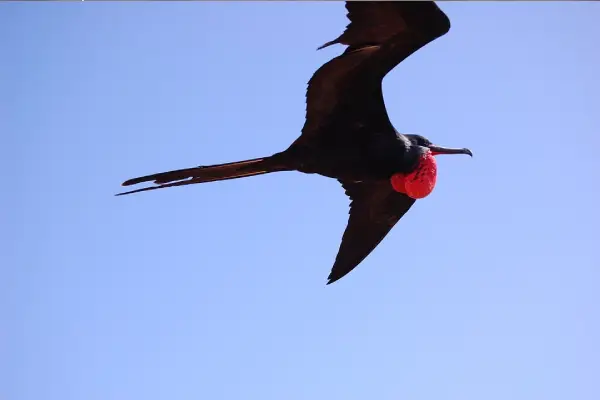
- Scientific Name: Fregata minor
- Lifespan: up to 40 years
- Body Length: 33-41 in
- Tail Length: 15.6-16.45 in
Great frigatebirds are huge seabirds that can grow up to 3.4 ft long, span 7 ft 7 in across the wings, and weigh as much as 3.5 lbs.
They can be found in the tropical Pacific and Indian Oceans, and in the South Atlantic Ocean.
Females tend to be bigger than males.
Males are completely black and have striking red gular sacs they inflate to attract mates; females have white throats.
Great frigatebirds also have very long, narrow, and deeply forked tails. Females have tails that are around 16.45 inches long; male ones are around 15.6 inches.
They have the highest ratio of wing area to body mass and the lowest wing loading of any bird – scientists speculate that this helps them soar at great heights and preserve energy.
Great frigatebirds are seasonally monogamous and stay together for a season.
As part of the courtship ritual, great frigatebirds will clatter their beaks, wave heads and wings, and males will call to females while flying overhead.
They are rather cheeky and will often steal fish and other food from other seabirds. They will chase and harass birds, make them regurgitate their food, and then swoop in and catch the food in the air.
Magnificent Frigatebird
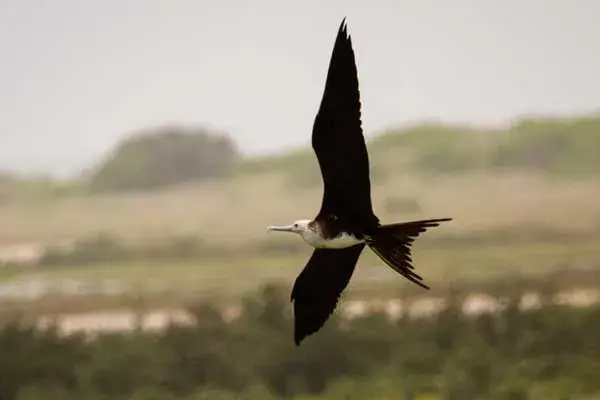
- Scientific Name: Fregata magnificens
- Lifespan: 14-30 years
- Body Length: 35-45 in
- Tail Length: 16.9-18.1 in
Magnificent frigatebirds are enormous seabirds common around coasts and islands in tropical and subtropical waters.
They are bigger than great frigatebirds and can measure almost 4 feet long, weigh 2.4-3.5 pounds, and span up to 8 feet across the wings; this makes them the largest species of frigatebird in the world.
In North America, they can be found in the Gulf of Mexico, around states like Texas and Florida.
They were named magnificent due to their striking appearance and behavior; these large red and black birds are easy to recognize due to their huge size, long pointed wings, and very long and hook-tipped beaks.
Males are all-black and have scarlet throat pouches they inflate like balloons during the breeding season; females are black but have white breasts and lower neck sides, while the juveniles also have white heads.
A study from 2019 discovered that females have longer tails and tail feathers compared to males.
Magnificent frigatebirds have very long and deeply forked tails that are around 16.9 inches long in males and 18.1 inches long in females.
These long-tailed black birds do not always have symmetrical tail streamers, but females do not seem to care – tail length was not useful to females as a quality indicator and there was no correlation between male tail length and male parental care performance.
Magnificent frigatebirds mostly feed on fish taken in flight from the ocean’s surface and their favorite food is flying fish, tuna, and squid.
They are kleptoparasitic – this means that they harass and steal fish from other animals.
Despite their massive wingspans, these birds can’t land on water as their feathers aren’t waterproof and they would most likely drown.
Great-tailed Grackle
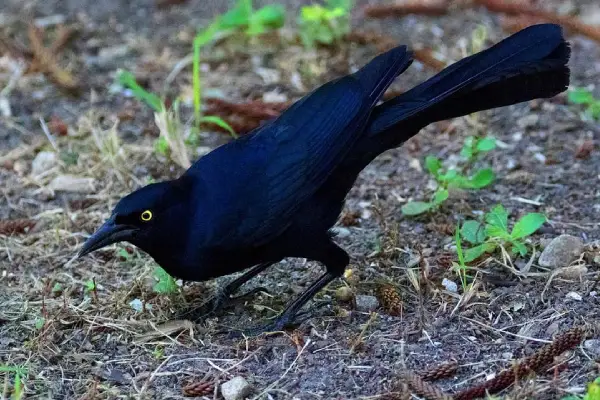
- Scientific Name: Quiscalus mexicanus
- Lifespan: up to 22 years in the wild
- Body Length: 15-18 in
- Tail Length: n/a
Also known as Mexican grackles, great-tailed grackles are medium-sized songbirds native to North and South America.
In the USA, they are common in central and southeastern parts of the country.
Male great-tailed grackles are iridescent black and have a blue sheen on their heads and upperparts; females are brown.
Males can be also recognized by their large keel-shaped tails; female tails are not keeled and are smaller than in males.
One 2010 study discovered that males are a lot glossier than females and that such glossiness correlated positively with tail length.
Great-tailed grackles sing multiple songs, ranging from sounding very sweet to sounding like a rusty gate hinge. Both sexes will also make low-pitched “chut” alarm calls.
Source: Niels Krabbe, CC BY-SA 4.0, via Wikimedia Commons
These black and blue birds begin breeding in mid-April and females will lay 4-7 bluish eggs with brown spots.
They inhabit pastures, wetlands, and mangroves, where they feed on insects, lizards, fruits, grains, worms, fish, and many other animals.
These highly intelligent and very social birds roost communally in groups ranging from several thousand to up to 500,000 birds!
Great-tailed grackles will nest in territories using 3 different strategies: they defend their territory with several females, they live in a colony but do not defend their territory or have mates, and they move from one colony to another after a few days.
Those males that form a territory are heavier and have longer tails than non-territorial males.
Read More: Examples of grackles found in Arizona
Eurasian Magpie
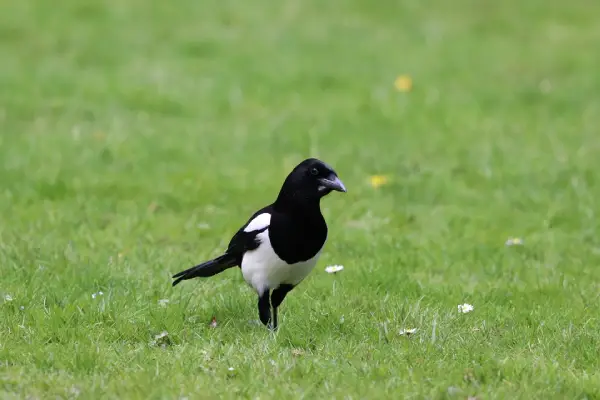
- Scientific Name: Pica pica
- Lifespan: 2-3 years in the wild
- Body Length: 17-18 in
- Tail Length: 4.7-11 in
These extremely intelligent birds are also known as common magpies and can be found around the open countryside with scattered trees of Europe, Asia, and northwestern Africa.
Eurasian magpies have glossy black heads, necks, and breasts, iridescent blue-green wings and tails, and the white color of their bellies and scapulars (shoulder feathers).
They measure from 17 to 18 inches in length – over half of that is the tail!
Eurasian magpies have black graduated tails (the longest feathers are in the center) that measure from 4.7 up to 11 inches.
Their most common call is a repeated “chac-chac“.
Source: Oona Räisänen (Mysid), Public domain, via Wikimedia Commons
These magpies are so intelligent that they can use tools, imitate human speech, grieve, play games, work in teams, and recognize themselves in a reflection (the mirror test).
The only non-human species that have passed the mirror test are the great apes, dolphins, elephants, and magpies.
These birds are omnivores that feed on young birds and eggs, small mammals, insects, carrion, acorns, and grain.
Eurasian magpies are monogamous and breed around spring. They will have a clutch of 3-10 pale blue-green eggs with brown marks that females incubate while the males feed them.
Marsh Widowbird
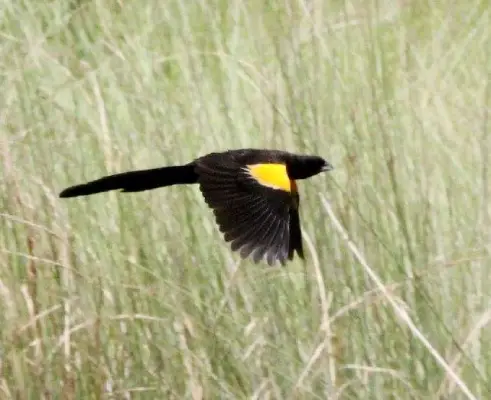
- Scientific Name: Euplectes hartlaubi
- Lifespan: n/a
- Body Length: 14 inches
- Tail Length: 6 in
Marsh widowbirds are large widowbirds commonly found in swampy grasslands and cultivated areas throughout Africa.
They breed in marshes and have a clutch of 1-3 greenish-blue eggs with olive-gray spots.
These black birds with long tails are also known as Hartlaub’s widowbirds.
Breeding male marsh widowbirds have long tails, black plumage, and yellow-orange wing patches. Their tails are around 6 inches long.
Females and non-breeding males are brown and streaky; males keep their yellow spots on the wings.
Marsh widowbirds can be also identified by their low rasps and twittering and sizzling calls.
Their song consists of short, rising “grrreeng” notes, followed by high-pitched “chritterwee” buzz or trill.
They are omnivores that feed on seeds, insects, and small fruits. They usually forage in small groups, often with other widowbirds.
Montane Widowbird
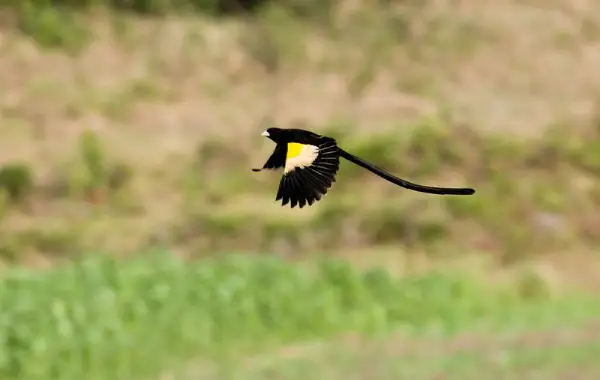
- Scientific Name: Euplectes psammacromius
- Lifespan: n/a
- Body Length: 5.9-12.6 in
- Tail Length: n/a
Montane widowbirds, also known as mountain marsh widowbirds, are black birds with yellow wings found in Africa.
They inhabit montane marshes, heaths, and grasslands of Zambia, Malawi, and Tanzania.
Similar to other widowbird species, their plumage varies between seasons.
Breeding males are all-black with yellow shoulder patches and long tails; non-breeding males and females are streaked and brown, although males keep their colorful shoulders.
Identify montane widowbirds by their low raspy and sizzling calls.
They are omnivores and feed on seeds and insects.
Montane widowbirds are territorial and considered polygynous species. They build dome-shaped nests using grass and females lay 2 pale olive-green eggs with brown spots and streaks.
Montane widowbirds tend to form larger flocks during the non-breeding season.
Males resemble marsh widowbirds – the main difference is their more extensive buff shoulder patches.
Long-tailed Widowbird
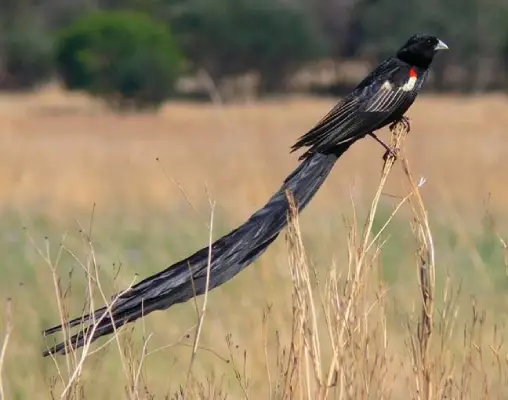
- Scientific Name: Euplectes progne
- Lifespan: n/a
- Body Length: 19.7-28 in
- Tail Length: 20 in
Long-tailed widowbirds are large black birds with extremely long tails.
They are also known as Sakabula and inhabit moist grasslands and other open habitats of Zambia, South Africa, Kenya, Lesotho, DR Congo, Botswana, and Angola.
These widowbirds are sexually dimorphic – males and females look different.
Male long-tailed widowbirds are completely black with orange and white shoulder epaulets and long and wide tails; females and non-breeding males are mostly brown and streaked.
Their tails have 12 feathers in total – between 6 and 8 of those are around 20 inches long.
Due to their extremely elongated tails, when it’s raining, males can’t fly.
But when they do, they will give a very slow display with their tails hanging down.
Scientists think that the reason males have such enormous tails is a sexual selection – female long-tailed widowbirds prefer supernormal tails and males with such remarkable ornaments have the most reproductive success.
Long-tailed widowbirds breed in grasslands and can be seen in flocks, especially during the non-breeding season.
Their breeding season lasts from February to July, females build nests above the ground and lay 1-3 bluish-green eggs with brown spots.
Identify long-tailed widowbirds also by their sizzling trill song.
Source: Charley Hasse, CC BY-SA 3.0, via Wikimedia Commons
Yellow-billed Cacique
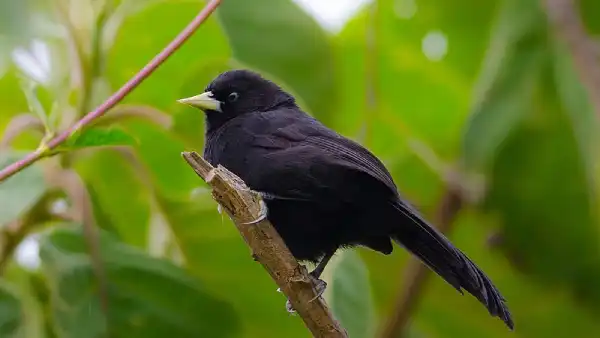
- Scientific Name: Amblycercus holosericeus
- Lifespan: n/a
- Body Length: 9 in
- Tail Length: n/a
Yellow-billed caciques are small New World blackbirds that have ivory-yellow bills.
They are completely black and have long and broad tails that are often frayed at the ends, dark gray legs and feet, and staring yellow eyes.
Yellow-billed caciques inhabit dense thickets, thick undergrowth in secondary forests, and abandoned agricultural clearings in forests.
They are common in Mexico, Central, and South America, in countries like Bolivia, Colombia, Honduras, Panama, Peru, etc.
Yellow-billed caciques are omnivores and feed on insects and some fruits.
They are seasonally monogamous and a pair will only stay together for a season. Yellow-billed caciques usually breed from November to June, depending on the region, and lay 1-5 eggs.
Unlike other caciques, this species builds an open cup nest using vines and leaves.
Yellow-billed caciques are mostly solitary and sedentary and prefer to stay hidden in thickets and brush.
Great Curassow
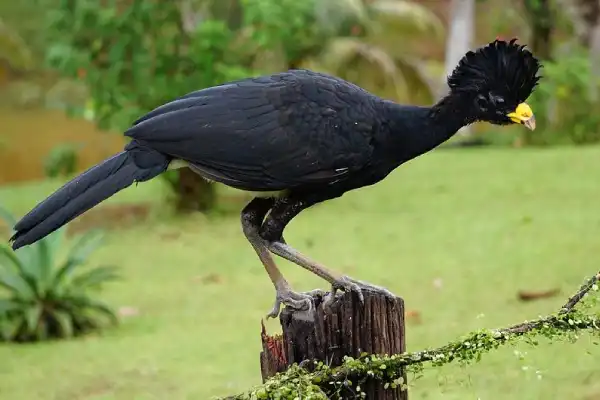
- Scientific Name: Crax rubra
- Lifespan: up to 24 years
- Body Length: 31-39 in
- Tail Length: 11-15 in
Yellow Great curassows are large pheasant-like game birds found in eastern parts of Mexico, Central America, and northern parts of South America.
They inhabit tropical and subtropical forests and are known for their distinctive curled head feathers and yellow bills with a round knob.
Male great curassows are black and have long tails that measure from 11 to 15 inches, taking almost one-third of their total body length.
Females are slightly smaller and have mostly rust-colored plumage.
Identify them by their low-pitched booming or whistling calls.
Great curassows are monogamous, use sticks, vines, and leaves to build their nests high off the ground, and lay 2 white round eggs.
They are omnivorous and feed on seeds, fruits, and invertebrates.
They usually forage on the ground, alone or in small groups, and might scrape the ground in pursuit of the next meal; their sturdy beaks are an important adaptation for such feeding behavior.
Due to logging, overhunting, and pet trade, great curassows are now listed as Vulnerable by the International Union for Conservation of Nature (IUCN).
Read more about the most colorful tropical birds here.
Magpie Shrike
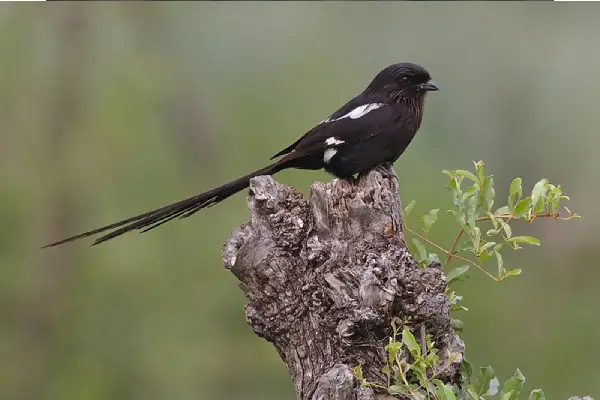
- Scientific Name: Urolestes melanoleucus
- Lifespan: n/a
- Body Length: 13.4-19.7 in
- Tail Length: 8.2-13.8 in
Magpie shrikes are bulky black shrikes native to Africa.
They inhabit dry savannahs, moist savannahs, and dry shrublands of Zimbabwe, Zambia, Tanzania, South Africa, Namibia, Kenya, Mozambique, Botswana, and Angola.
Identify magpie shrikes by their mostly black plumage and very long and graduated black tails that measure from 8.2 to 13.8 inches in length.
They also have white scapulars and grayish-white rumps, black beaks, and black legs and feet.
Identify these very noisy birds by their territorial whistling “kee-oo” calls, alarm “chac” calls, and “teeloo” and “tleu” sounds partners make in a duet.
Source: Lütgens, Hans (collector), CC BY-SA 4.0, via Wikimedia Commons
They love to sit upright on perches, in groups of 3-10 birds, looking for the next meal and displaying their enormous tails.
Magpie shrikes are omnivores that forage on the ground or in the air and feed on insects, small lizards, small mammals, berries, and fruit.
They are monogamous and mate for life; both mates will use twigs, grass, rootlets, and plants to build the nest, females will lay 3-5 yellowish eggs with dark spots, and males will feed them as they incubate the eggs.
As part of their courting ritual, males will bow, flick their tails, and whistle.
Long-tailed Starling
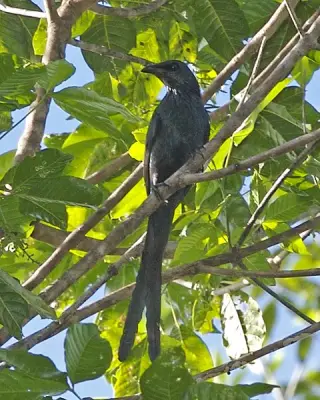
- Scientific Name: Aplonis magna
- Lifespan: n/a
- Body Length: 11-16 in
- Tail Length: 5 in
Long-tailed starlings are large long-tailed birds endemic to Indonesia.
There are 2 subspecies – one found on Biak Island (nominate subspecies) and the other found on Numfor Island.
They inhabit forests, forest edges, and gardens.
Long-tailed starlings measure 11-16 inches in length, including the tail that can be as longer than the body length in nominate subspecies; the other subspecies have tails that are around two-thirds of the body.
In the wild, these starlings cock and fan their huge tails.
They have black plumage with glossy backs, necks, and chests, black feet and beaks, and brown eyes.
Identify long-tailed starlings by a series of loud warbles and grating calls.
They are often seen in groups, perching on open branches. Long-tailed starlings are herbivores and feed on fruit.
Common Raven

- Scientific Name: Corvus corax
- Lifespan: 10-15 years in the wild
- Body Length: 21-26 in
- Tail Length: 8-10.4 in
These massive black birds can weigh up to 4.4 pounds and span 4 feet 3 inches across the wings.
Common ravens are one of the biggest and heaviest songbirds and are commonly found in open and forest habitats across the US.
Identify adults by their large size, big and curved beaks, and dark brown eyes.
Common ravens are iridescent black birds with long and strongly graduated tails that measure from 8 to 10.4 inches – almost a third of their total body length!
They look like crows but are much bigger, weigh more than four times, and have wedge-shaped tails compared to crows’ fan-shaped ones.
These highly intelligent animals have one of the largest brains of all birds; they display great ability in problem-solving, using tools, planning for the future, and even playing games like hide-and-seek.
Common ravens are omnivores that feed on almost anything; they will consume carrion, insects, cereal grains, berries, fruit, small animals, nesting birds, and food waste.
They will even resort to “trickery” when hiding food – they will pretend to put the food in one place while actually placing it in another.
Identify common ravens by their gurgling croaks that rise in pitch.
Source: NPS/David Restivo, Public domain, via Wikimedia Commons
Greater Racket-tailed Drongo
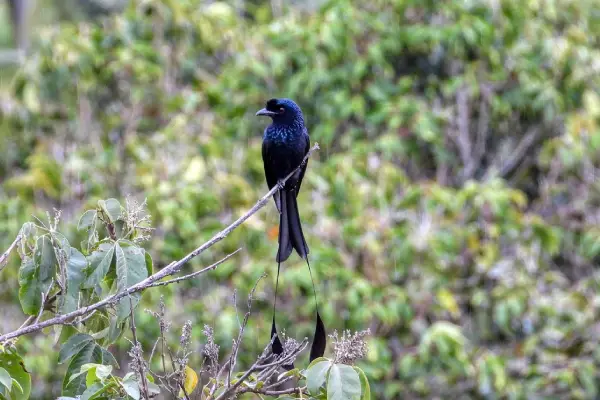
- Scientific Name: Dicrurus paradiseus
- Lifespan: n/a
- Body Length: 11.8-25.6 in
- Tail Length: 11 in (varies)
Greater racket-tailed drongos are medium-sized birds found in Asia.
They inhabit woodlands and forests and can be often seen perching in the open.
Identify greater racket-tailed drongos by their bluish-black plumage, notched tails with long and distinctive tails rackets, and head crests.
Their elongated tails take almost half of their total body length and in flight, it might appear as if two large bees are chasing them.
They are rather noisy birds that make metallic jingling sounds and often imitate other birds.
Source: L. Shyamal, CC BY-SA 2.5, via Wikimedia Commons
Look for them in mixed flocks with other drongos, treepies, and babblers.
Greater racket-tailed drongos breed from April to August and have a clutch of 3-4 creamy white eggs with brownish spots.
They are omnivores and feed on insects and nectar.
American Crow
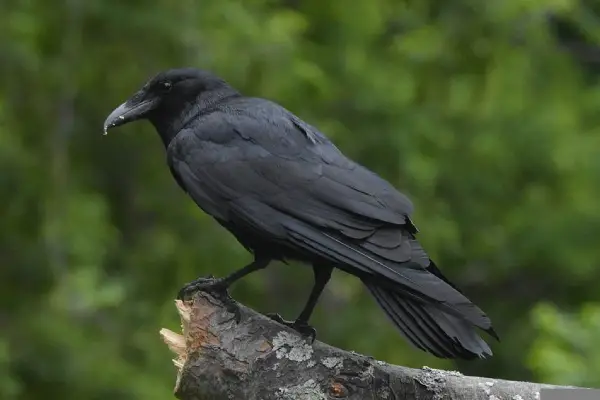
- Scientific Name: Corvus brachyrhynchos
- Lifespan: 7-8 years in the wild
- Body Length: 16-20 in
- Tail Length: 5.3-7.5 in
These large and aggressive black birds are found throughout most of North America.
Despite having very harsh-sounding calls, American crows are considered songbirds.
Adults can be recognized by their all-black plumage, long tails, and large bills.
American crows measure from 16 to 20 inches in total – almost 40% of which is the tail. Their tails measure from 5.3 to 7.5 inches and have a fan-shaped appearance during flight.
They can be often found around woods and urban areas and can be recognized by their loud, short, and rapid “caaw-caaw” calls.
Source: G McGrane, Public domain, via Wikimedia Commons
Often associated with trickery and death, American crows are large and intelligent birds with an IQ similar to that of chimpanzees.
These birds are omnivores and feed on earthworms, insects, other small animals, seeds, fruit, even garbage, and carrion.
Black Drongo
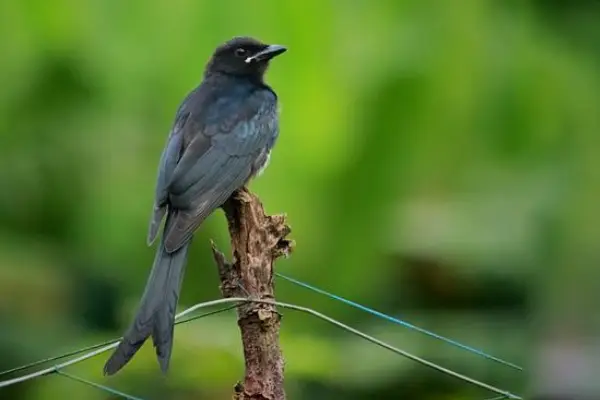
- Scientific Name: Dicrurus macrocercus
- Lifespan: n/a
- Body Length: 11 in
- Tail Length: n/a
Black drongos are small glossy black birds with long tails.
These Asian songbirds inhabit China, Indonesia, Sri Lanka, Bangladesh, India, and Iran.
They measure around 11 inches in length and can be often seen perching in open agricultural areas and light forests; black drongos inhabit farmlands, forest edges, meadows, wetlands, and fields.
Identify them also by their dark brown eyes and small white spots at the base of their beaks.
Their long tails are deeply forked; young develop the split in their tails around the third week.
Despite their smaller size, black drongos will attack larger birds that enter their territories, including crows and kites.
They can make powerful sounds that include various scrapping calls, harsh “schweep-schweep” calls, and some melodic whistles. Pairs will also sing in duets.
Source: Gypsypkd, Public domain, via Wikimedia Commons
Black drongos nest high in trees, make loose cup nests using twigs, leaves, and grass and have a clutch of 2-5 pinkish-white eggs with brown spots.
These long-tailed birds are omnivores and have a diet consisting of insects, small reptiles, birds, bats, and flower nectar.
Southern Ground Hornbill

- Scientific Name: Bucorvus leadbeateri
- Lifespan: 40-50 years
- Body Length: 35.4-50.8 in
- Tail Length: 11-14 in
Southern ground hornbills are the largest hornbill species in the world.
They have a wingspan of almost 6 feet and can weigh from 4.9 to 13.7 pounds.
Southern ground hornbills measure 35-51 inches long and have sizeable tails ranging from 11 to 14 inches – that’s almost one-third of their total length.
Identify males by their completely black plumage with vivid red patches of bare skin on their faces and throats, and the large, down-curved beaks they use to catch small animals found in the grasses and shrubs.
Females are also black but have bluish throats.
Southern ground hornbills are commonly found in Southern Africa and inhabit both woodlands and savannas.
As the name suggests, they will stay most of their time on the ground.
They can fly but some studies discovered that they spend around 70% of their day walking.
Southern ground hornbills are apex predators that hunt reptiles, frogs, snails, insects, and hare-sized mammals.
In the early morning, the song of these red-necked birds can be heard from miles away, with pairs singing in a duet with a deep-bass booming “oooh-oooh-ooh-oh” sounds.
Southern ground hornbills are long-lived species that can live up to 70 years in captivity!
Read More: More examples of incredible birds that have red necks
White-winged Widowbird
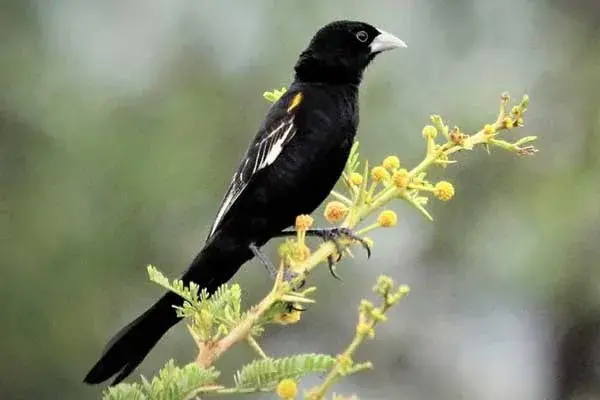
- Scientific Name: Euplectes albonotatus
- Lifespan: n/a
- Body Length: 5.9-7.5 in
- Tail Length: 1.6-3 in
White-winged widowbirds are polygynous, territorial, and solitary nesting birds.
They inhabit savannas, grasslands, wetlands, as well as cultivated lands of Africa south of the Sahara.
These birds are highly sexually dimorphic during the breeding season.
Breeding male white-winged widowbirds have black plumage, pale blue beaks, brightly-colored shoulder epaulets, and white wing panels seen during flight.
Non-breeding males have buffy and streaky plumage; females do not have similar wing patterns and have pale unstreaked bellies.
Despite not being as “gifted” as their relatives, white-winged widowbirds still have long tails that measure up to 3 inches and take almost 40% of their total body length.
Identify these birds by their “zeh-zeh” and “witz-witz” calls.
White-winged widowbirds are omnivores that feed on grass seeds, nectar, and insects.
Anhinga
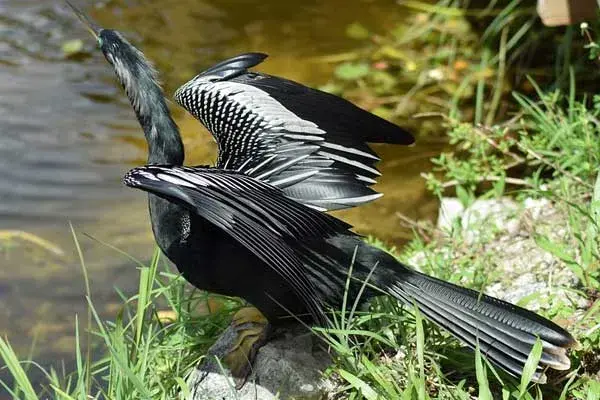
- Scientific Name: Anhinga anhinga
- Lifespan: 12 years
- Body Length: 30-37 in
- Tail Length: 8.4-10.2 in
These large and glossy black water birds are commonly found around lakes, freshwater marshes, ponds, and canals of southern USA, Mexico, Central, and South America.
When they swim, only their long necks and beaks appear above water, making them look like snakes – that’s why people named them snakebirds.
Males are black with white spots on their wings and backs while the females look similar but have brownish necks and heads.
Anhingas also have yellow pointy beaks and long tails that are often spread in flight.
Their tails measure from 8.4 to 10.2 inches long and represent around 30% of the birds’ total length.
Due to having such turkey-like tails, people have also nicknamed them “water turkeys”.
These black birds can be also identified by their loud clicking calls that resemble sewing machines or croaking frogs.
Source: National Park Service, Public domain, via Wikimedia Commons
Anhingas do not have waterproof wings as other birds do and can be often seen drying their feathers in the sun.
They are carnivores that feed on fish, insects, shrimp, crayfish, and sometimes even young alligators and snakes.
White-browed Wagtail
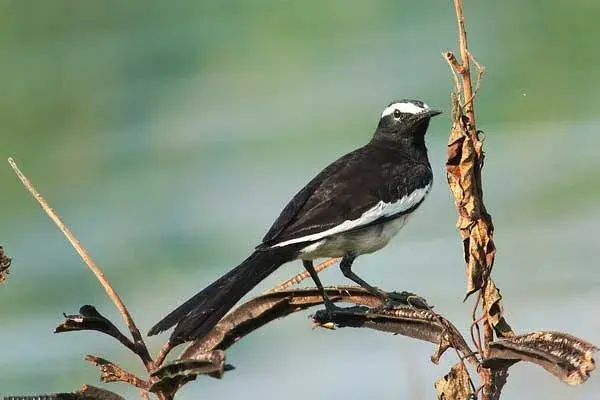
- Scientific Name: Motacilla maderaspatensis
- Lifespan: 2 years
- Body Length: 8.3 in
- Tail Length: n/a
These medium-sized birds with prominent broad white eyebrows are also known as large pied wagtails.
White-browed wagtails are the largest members of the wagtail family and measure around 8.3 inches in length and have a wingspan of 12 inches.
Adults have black heads, backs, upper tails, white chests, bellies, and parts of their wings.
White-browed wagtails also have characteristically long and constantly-wagging tails.
Notice their long and loud song consisting of many different notes; their most common call is a wheezy “wheech“.
Source: Shyamal, CC0, via Wikimedia Commons
They are common around open freshwater wetland habitats of South Asia.
Just like other wagtails, white-browed ones are insectivorous and feed on beetles, dragonflies, small snails, spiders, worms, crustaceans, and flies.
Part of their scientific name, “maderaspatensis” comes from the Indian city of Madras (now Chennai).
People used to keep white-browed tails as cage birds due to their amazing looks and singing abilities.
Oriental Magpie-robin
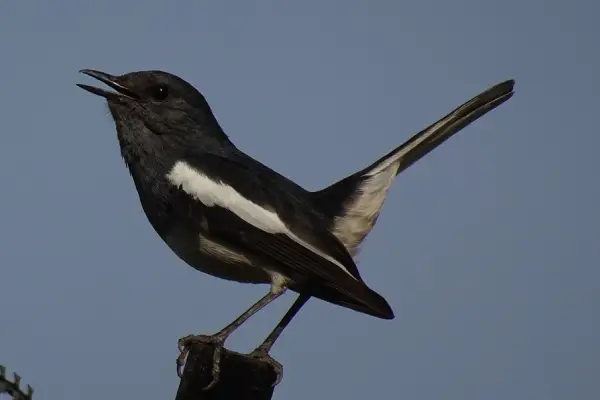
- Scientific Name: Copsychus saularis
- Lifespan: 10-15 years
- Body Length: 7.5 in
- Tail Length: n/a
Oriental magpie-robins are small perching birds with long tails held upright when foraging or when perching on trees.
They are common in India and southeastern parts of Asia, inhabiting open woodland and cultivated areas often close to human habitations.
Oriental magpie-robins are the national birds of Bangladesh.
Males are black above with white heads and throats, and black wings with broad white wingbars running from the shoulder to the tip of the wings.
Females are paler than males, grayish-black above and grayish-white below.
They were often kept as cage birds due to their singing ability.
In the wild, oriental magpie-robins can be often heard and seen singing from a high exposed perch; they are also great at mimicking songs of other birds.
Source: T. R. Shankar Raman, CC BY-SA 4.0, via Wikimedia Commons
When they sing during their courting ritual, males will move their long tails up and down in synchrony with the tune.
They are omnivores and feed on insects, spiders, fruits, seeds, and even small animals such as geckos and fish.
Summary
This concludes our list of black birds with long tails.
Examples of long-tailed black birds include several types of hornbills, drongos, frigatebirds, widowbirds, magpies, crows, and many others.
The next time you see any of these birds, you should be able to recognize them with ease!
And if you enjoyed our article, here are our other popular reads on birds: Examples of black birds that have white bellies